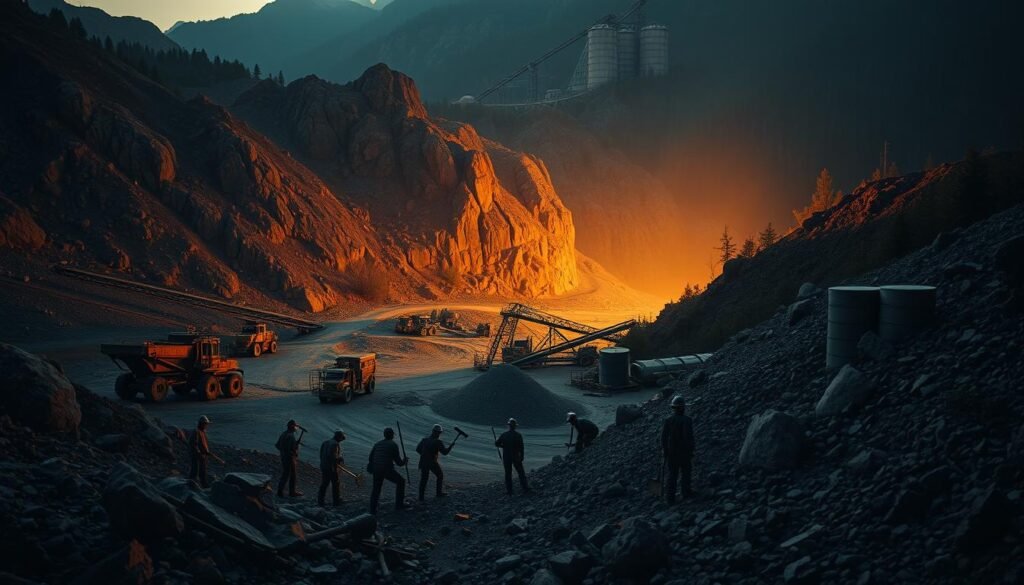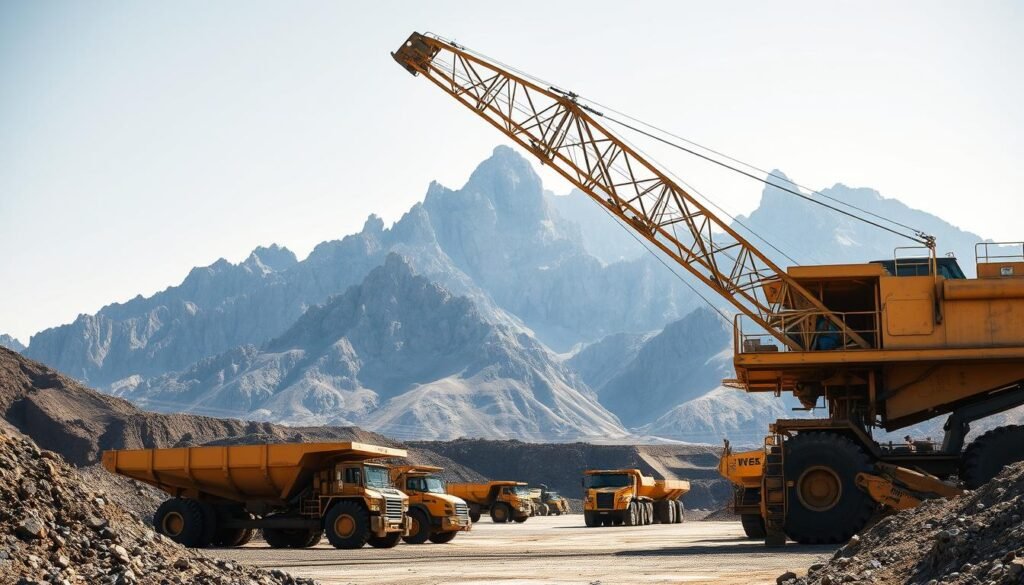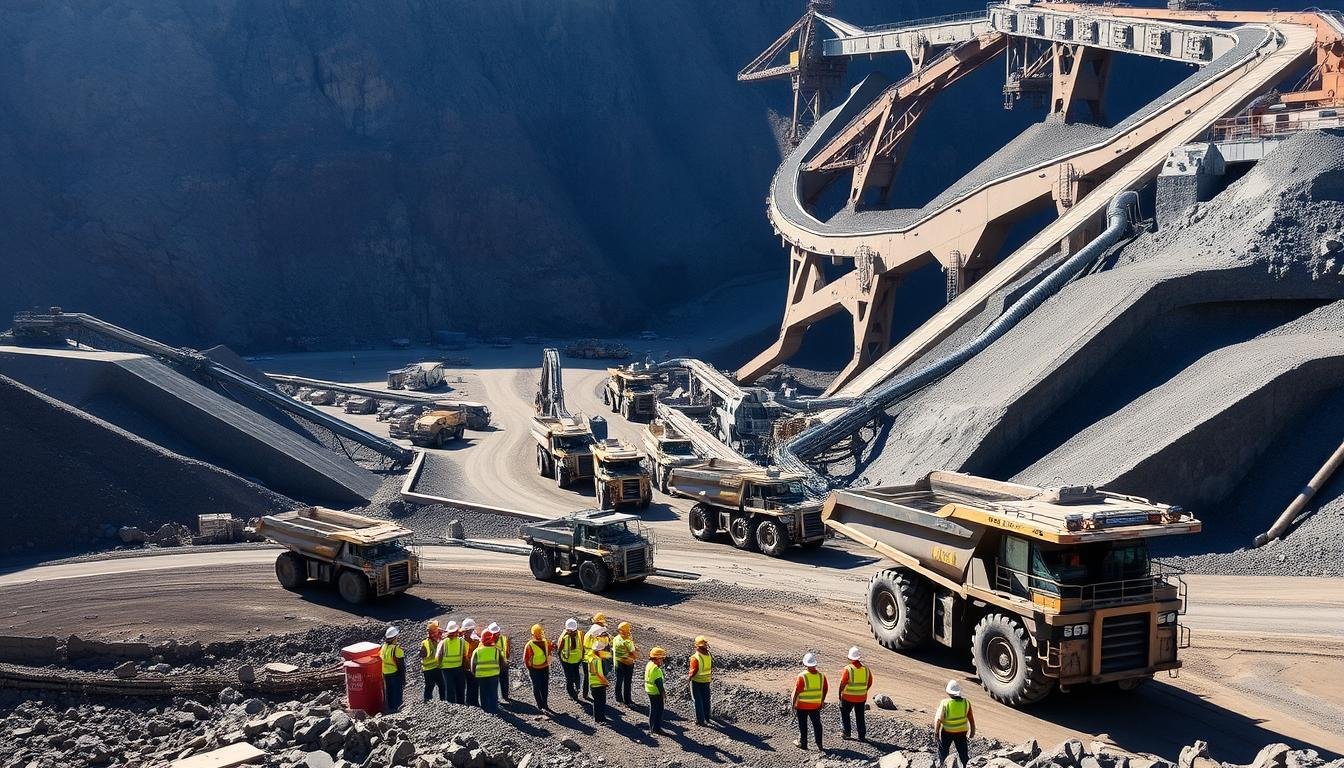Did you know that the mining industry contributes over $600 billion to the United States economy each year? This staggering figure underscores the vital role that mining plays in providing essential materials for infrastructure, technology, and energy sectors. If you’re curious about what are the basics of mining, you’re in the right place. Understanding mining basics is crucial, as it sets the stage for a deeper exploration of its history, processes, regulations, and its impact on the economy.
From early mining techniques to modern advancements, you will discover how this industry has evolved and continues to shape our daily lives. The ongoing mining industry trends reveal the importance of adaptability and innovation in ensuring efficiency and safety in mining operations. As you delve into the various methods of mining and explore critical topics related to the field, you’ll gain a clearer understanding of how mining techniques influence both local communities and the broader economic landscape.
Key Takeaways
- The mining industry contributes over $600 billion to the U.S. economy annually.
- Mining is essential for providing materials used in infrastructure and technology.
- Understanding the mining process helps in grasping its impact on the economy.
- Innovations in mining techniques enhance efficiency and safety.
- Adaptability is crucial to keep up with mining industry trends.
What Is Mining?
Mining represents a crucial activity focused on the extraction of valuable minerals and geological materials from beneath the Earth’s surface. This process involves various techniques and methods, each contributing uniquely to the industry. You may find it interesting to learn about the different methods of mining, including surface mining and underground mining.
Definition of Mining
The term ‘mining’ encompasses the broad spectrum of activities aimed at retrieving precious resources from the Earth. It can involve the removal of minerals, coal, or metals with significant economic value. Recognizing these mining basics aids in grasping its significance in societal development.
Types of Mining Methods
There are two primary types of mining:
- Surface Mining: This method extracts materials from the Earth’s surface, making it easier and less expensive than other techniques.
- Underground Mining: This technique involves retrieving minerals from deep within the Earth, often requiring more advanced technology and extensive safety measures.
Importance of Mining in the Economy
The mining sector plays a vital role in the U.S. economy by providing essential materials for construction and energy sources. You benefit from this industry as it generates jobs and drives innovation, ensuring a steady supply of resources that are essential for daily life and industrial activities.
History of Mining in the United States
The history of mining in the United States reflects a journey through time that begins with early practices and advances into modern mining techniques. Understanding this evolution helps you grasp the mining basics and the impact that mining has had on the nation’s economy. From the ancient methods to the bustling gold rush, all have shaped the landscape of resource extraction in America.
Early Mining Practices
Indigenous peoples practiced mining long before European settlers arrived, utilizing available resources for tools and trade. Mining practices during this time were not only about extraction but were also deeply intertwined with cultural practices and sustainability. As settlers began to explore, they adopted similar methods, leading to an expanded focus on minerals and gems.
The Gold Rush Era
The gold rush of the mid-19th century marked a significant turning point in the history of mining. The discovery of gold in California drew thousands seeking fortune, igniting westward expansion. This surge transformed not just the mining industry but also the economy, establishing mining towns and impacting transportation and commerce across the country.
Modern Mining Developments
In recent decades, modern mining has evolved dramatically due to technological advancements and changes in regulations. Innovative techniques and enhanced safety practices have been introduced to address the challenges that the industry faces. Today’s mining operations are more efficient and environmentally conscious, meeting both the demands for resources and the need for sustainable practices.
Mining Regulation and Safety Standards
Understanding the landscape of mining regulation and safety standards is essential for anyone involved in the mining industry. In the United States, various mining regulations ensure that operations maintain a safe and environmentally responsible approach. This regulatory framework adapts to emerging mining industry trends, focusing on enhancing both safety and operational efficiency.
Overview of Mining Regulations
The mining sector is governed by a combination of federal and state regulations designed to safeguard workers and the environment. These mining regulations establish protocols that companies must follow to minimize hazards and ensure responsible resource extraction. Federal legislation, including the Federal Mine Safety and Health Act, provides a baseline for safety initiatives, while state laws often introduce additional layers of compliance.
Key Regulatory Agencies
Several key regulatory agencies oversee compliance with mining regulations in the U.S. The Mine Safety and Health Administration (MSHA) plays a pivotal role in enforcing safety standards related to worker health and safety. The Environmental Protection Agency (EPA) is another significant agency, tasked with ensuring that mining practices do not negatively impact the environment. By collaborating with these agencies, companies can better navigate regulatory requirements and adapt to ongoing changes within the industry.
Importance of Safety in Mining Operations
Prioritizing safety in mining operations is essential not only for compliance with mining regulations but also for the well-being of workers. Effective safety measures reduce workplace accidents and ensure a sustainable approach to resource extraction. Industry trends indicate a growing emphasis on developing innovative strategies that both enhance safety and protect the environment. You can explore more about essential guidelines and best practices by checking out mining safety rules and regulations. Implementing these strategies benefits both the workforce and the bottom line.
Types of Minerals and Resources Extracted

Understanding the diverse array of resources extracted through mining is essential for grasping the mining basics. From essential metals to energy resources, each type plays a vital role in today’s economy. You will find that mining provides us with not only commonly mined minerals but also the energy we rely on daily.
Commonly Mined Minerals
Among the commonly mined minerals, you’ll encounter a variety of important materials. Notable examples include:
- Gold
- Copper
- Iron
- Aluminum
These minerals serve crucial functions in various industries, from construction to electronics, highlighting their significance in our lives.
Energy Resources: Coal and Natural Gas
When discussing energy resources, coal and natural gas deserve special mention. These fossil fuels are integral to electricity generation and heating. You can learn more about how mining plays a role in securing energy resources by visiting this page.
Precious Metals and Gemstones
Precious metals, including silver and platinum, along with gemstones like diamonds and emeralds, are another facet of mining. Their extraction not only supports industrial applications but also drives the jewelry market, enhancing their allure and value. The demand for these precious metals and gems continues to be strong, influencing mining practices globally.
The Mining Process Explained
Understanding the mining process is crucial for appreciating the complexities involved in extracting valuable resources. This process encompasses various stages, beginning with prospecting and exploration, followed by extraction methods, and concluding with the steps related to processing and refinement. Each stage employs unique mining techniques that contribute to the efficiency and effectiveness of resource recovery.
Prospecting and Exploration
Before any extraction can occur, the initial phase involves thorough prospecting and exploration. Geologists survey potential sites to identify where valuable minerals are located. Various techniques are utilized, including:
- Geological mapping
- Geophysical surveys
- Geochemical testing
Through these methods, companies can assess the viability of a site, ensuring that valuable resources can justify the costs of mining.
Extraction Methods
Once a site has been determined to hold sufficient resources, several extraction methods come into play. Each method is tailored to the type of material being mined and includes:
- Open-pit mining: Ideal for shallow deposits, this method involves removing large quantities of surface materials.
- Underground mining: Used for deeper deposits, this technique requires constructing tunnels to access the ore.
The choice of extraction methods directly influences the efficiency and safety of mining operations.
Processing and Refinement
Following the extraction of materials, processing and refinement become essential to separate valuable minerals from waste. Techniques in this phase may involve:
- Crushing and grinding the ore
- Gravity separation
- Chemical processing
This meticulous process maximizes recovery rates and ensures that the materials extracted yield the best possible returns. Understanding these phases highlights the skill and technology involved in modern mining practices.
Technology’s Role in Mining Today

Technology has dramatically transformed the mining industry, making it more efficient and safer. The latest advancements in mining equipment have redefined how operations are performed. Heavy machinery such as excavators and drillers now integrate state-of-the-art features that optimize performance and reduce human error.
Advanced Equipment Used in Mining
Modern mining relies on advanced equipment designed to enhance productivity and ensure safety. Equipment like autonomous trucks and high-capacity drills maximize output while minimizing environmental impact. This advanced mining equipment allows you to complete tasks more quickly and efficiently, ensuring a stronger bottom line.
Role of Automation and Robotics
Automation in mining is on the rise, with robotics playing a crucial role in various stages of the mining process. Automated systems can operate machinery without constant human supervision, reducing labor costs and enhancing efficiency. Increased use of automation not only streamlines operations but also lessens the risks inherent in mining.
The Impact of Technology on Safety
Technological impacts on safety are profound, as smart technologies help in predicting and preventing accidents. Sensors and monitoring systems can provide real-time data on equipment status and environmental conditions, allowing for proactive measures to ensure worker safety. For more insights on these technological innovations, consider exploring this resource, which outlines various advancements reshaping the mining landscape.
Environmental Considerations in Mining
Understanding the environmental impact of mining is crucial for balancing resource extraction with ecological integrity. Before any mining project begins, conducting an Environmental Impact Assessment (EIA) helps evaluate potential environmental consequences and guides necessary mitigation strategies.
Environmental Impact Assessment (EIA)
An EIA serves as an essential tool in the planning stages of mining operations. This assessment identifies possible harm to local ecosystems and communities, ensuring that stakeholders address concerns proactively. Comprehensive studies in various regions have highlighted specific challenges, such as habitat disruption and water contamination. For a deeper understanding of these issues, you can explore the challenges outlined in environmental problems caused by mining.
Sustainable Mining Practices
Adopting sustainable mining practices plays a vital role in minimizing the environmental impact of mining. These practices include:
- Utilizing cleaner technologies to reduce emissions
- Implementing effective waste management systems
- Ensuring water conservation and quality protection
Engaging in responsible mining not only benefits the environment but also enhances the industry’s reputation among consumers and investors.
Rehabilitation of Mining Sites
Post-extraction rehabilitation is essential in restoring mining sites to their original state or transforming them into productive landscapes. This process involves:
- Revegetation with native plant species
- Monitoring soil stability and health
- Creating wildlife habitats to support local biodiversity
Successful rehabilitation efforts demonstrate a commitment to environmental stewardship, allowing ecosystems to recover and thrive after mining activities cease. Emphasizing rehabilitation ensures that mining can coexist with nature, paving the way for a more sustainable future.
The Future of Mining in the United States
As the mining industry evolves, various elements come into play that shape its trajectory. Understanding the mining industry trends is crucial for anyone involved or interested in this field. The future of mining heavily relies on technology, sustainability, and regulatory frameworks. These factors not only present challenges in mining but also open doors for innovation and growth.
Trends Shaping the Industry
Current mining industry trends highlight a shift towards more sustainable practices. Green mining technologies are emerging, aiming to minimize environmental impact while enhancing efficiency. Ethical sourcing is becoming a priority, ensuring that materials are obtained responsibly. Adapting to these trends can position you advantageously in a competitive market.
Challenges Facing Miners
The mining sector faces several challenges that impact its growth and stability. Regulatory pressures continue to tighten, necessitating compliance with stringent laws aimed at protecting the environment. Additionally, public scrutiny over the industry’s environmental footprint poses significant challenges in mining practices. Navigating these obstacles requires strategic planning and adaptability.
Opportunities for Growth and Innovation
Despite its challenges, the future of mining also reveals a landscape ripe with opportunities. Emphasizing modernization can lead to innovative solutions that enhance sustainability and efficiency in your operations. Partnerships with technology providers may help address these challenges, paving the way for a more resilient mining future.
How to Get Involved in the Mining Industry
Embarking on a career in mining offers numerous opportunities for growth and development. Whether you’re a recent graduate or someone looking to switch career paths, understanding the educational pathways that lead to careers in mining is crucial. Degrees in fields like geology, engineering, and environmental science provide you with the foundational knowledge necessary to succeed in this evolving industry. Additionally, specialized training programs and certifications can further enhance your skills and marketability.
Joining professional organizations is another effective way to dive into the mining field. Associations such as the Society for Mining, Metallurgy, and Exploration (SME) offer resources and networking opportunities that can connect you with industry leaders and fellow professionals. Becoming a member allows you to stay informed about emerging trends and innovations, which can greatly benefit your career trajectory.
Networking is essential in the mining sector, as relationships often lead to job opportunities and collaborations. Attending industry conferences, workshops, and seminars can help you build a vital network of contacts. Moreover, engaging in online forums and social media groups dedicated to mining can provide additional support and resources, setting you on the path toward a fulfilling career in mining.
